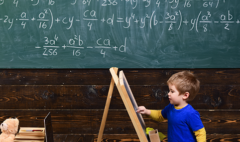Look for and Express Regularity in Repeated Reasoning
March 11, 2021 2021-04-01 13:57Look for and Express Regularity in Repeated Reasoning
Look for and Express Regularity in Repeated Reasoning
It has been well said that the highest aim in education is analogous to the highest aim in mathematics, namely, not to obtain results but powers, not particular solutions, but the means by which endless solutions may be wrought. George Eliot, 1885
In the previous standard (Look for and use the structure of mathematics), the framers of CCSS-M and SMP placed an emphasis on students learning to observe and appreciate the structure of mathematics—paying attention to its unique properties and systems, big ideas, and organizing principles, appropriate to their age and grade level. The goal of this standard is to help students to see the nature and appreciate the power of mathematics.
The eighth standard: Look for and express regularity in repeated reasoning promotes the ability to recognize quantitative (numeric) or spatial (geometric) patterns, make connections, and use those patterns to arrive at an understanding of mathematics structures—the general methods, the reasons behind the efficiency and elegance of algorithms/procedures, work out effective strategies, properties of numbers and operations at their grade levels.
In the previous standard, students looked for and used the structures in mathematics to apply them to learn more mathematics and solve problems. In this standard, the aim is to develop those structures from concepts and even construct new ones—new to students or even new to mathematics at their grade level. This process provides skills for students to own, retain and communicate, efficiently, accurately, and with rigor, the understanding and mastery of mathematics content. It also means developing the awareness of their own learning and the nature of mathematics conceptualization—the patterns. But most importantly, the objective is to help students to create interest in mathematics and to continue it with accuracy, confidence, and enthusiasm beyond school.
Mastery of this standard allows students to complete the cycle of learning mathematics: try problems, recognize a pattern in the solution process, discern a pattern(s), see the mathematics structure in the pattern, generalize the terms of that structure, generate a conjecture, test the conjecture, and then arrive at a key concept, procedure, strategy, or relationship between different elements of mathematics.
What is a pattern?
A pattern is a relationship between many of pieces of data, that is on going, something that is repeating—a data or a relationship between data, and can be predicted either explicitly or implicitly. Can one have a pattern when there are one, two, or three pieces of data? One piece of data is an incident, two are a coincident, with three there is a possible beginning of a pattern. If there is definite relationship between these pieces of data, then one needs a fourth one to verify that pattern.
Observing patterns and regularity in processes is the key to learning and using the prerequisite skills for mathematics learning. Students experience and develop affinity for mathematics when they also develop the prerequisite skills for mathematics learning. These prerequisite skills include: ability to follow sequential directions, classification, organization, quantitative and spatial reasoning, visualization, deductive and inductive reasoning. In designing lessons, therefore, teachers must also include the development of these prerequisite skills in addition to introducing interesting and relevant content. However, they should be integrated rather than isolated exercises.
A central idea here is that mathematics is drawing general results (or at least good conjectures for the moment) by trying examples and looking for regularity in the results generated by these patterns. In this standard, we want students to experiment with examples and arrive at patterns and then generalize those patterns to arrive at workable rules and procedures.
When students have explored several problems related to a concept, a few inevitably say, “I see a pattern here, so do I have to do all this work?” This is where the teacher moves the learning into generalizing mode—using the pattern to arrive at a conjecture, testing it and then arrive at the procedure or rule. She can’t stop at the pattern level. Students need to test their pattern as well as to recognize it in diverse situations and construct counter examples or non-examples. For example, instead of teaching just the rules for combining integers, students should look at patterns of combining numbers to generalize and come up with the rule. In the number -3, the digit 3 is the numeral and -3 is the number. Thus, a number is a directed numeral.
Mathematically proficient students develop two opposing but intertwined abilities: persevering in solving problems and looking for generalizable, efficient methods (i.e., short-cuts). These students notice patterns in calculations, use those patterns to create shortcuts, and learn multiple algorithms for the same idea and choose the appropriate one for the context. This helps them to do more interesting mathematics with less effort, thus generating an inclination for mathematics.
On the other hand, low achieving students lack both these qualities. As a matter of fact, low achieving students work harder in mathematics classes as they persevere using inefficient and long-drawn out methods, for example, they will use counting for learning addition and subtraction facts rather than efficient strategies based on decomposition/recomposition. Partly, it is not their fault; they have been instructed to do so. Because of these laborious methods, they give up easily. For them mathematics becomes hard, uninteresting, and a collection of unrelated procedures because they are not given help to develop efficient strategies and practice in seeing patterns and mastering strategies.
Solving many problems develops students’ inductive reasoning, and then justifying and communicating their thinking develops deductive reasoning. Inductive and deductive thinking are essential components of the mathematical way of thinking. The SMP classrooms are expected, through these practices, to develop habits of higher order thinking skills. Synthesizing concrete models and examples into symbolic and abstract ideas, at the elementary school, are good examples of applications of inductive reasoning. In contrast, most middle school and high school concepts and procedures are based on deductive reasoning or analysis.
Habits of mathematical thinking (observing patterns, looking for structure and regularity, repeated reasoning, making conjectures, providing examples, and counter examples, etc.) enrich learners’ problem solving experiences. By looking for patterns, developing conjectures, making discoveries and inferences, generalizing results, monitoring the solving process, checking the reasonableness of answers, and devising new avenues to explore to make learning mathematics engaging, they develop the habit of persevering (increasing stamina) for problem solving and communicating what they know.
Mathematical practices such as constructing reasoning and critiquing the reasoning of others are examples of deductive reasoning; however, this particular standard is best developed when students have extensive experiences in inductive reasoning. Observation of regularity, patterns, structure, and symmetry develops inductive reasoning. Further, practice of formal mathematics logic and reasoning such as supporting arguments and formal proofs develops rigor and a deeper understanding of mathematics. Deeper understanding in mathematics is an integration of deductive and inductive reasoning: analysis and synthesis in the process of solving problems.
Being a student of mathematics means balancing both qualities. Sometimes one needs to persevere and to stick with a set of strategies that will definitely work, given time. Putting in the effort, even though it is hard, is necessary. But, the effort must be put in developing and using efficient methods and strategies. Getting stuck doing the same inefficient methods is not what being a mathematician is about. Mathematicians explore new approaches and look for efficient and elegant solutions. They want methods to be powerful and generalizable. They effectively use what they know and have done to become efficient, more powerful problem solvers. They look for and represent regularity in repeated reasoning in order to develop efficient shortcuts or notations. This standard urges us, as teachers, to prepare and remind students that mathematicians move from painstaking but reliable problem-solving methods to efficient procedures via looking for regularity in their repeated reasoning.
Look for and express regularity in repeated reasoning.
Regularity and repeated reasoning abound in mathematics. Many facts, diverse terms, concepts and processes reoccur in the development of mathematical ideas. In this standard, the key words are: “look for” and “express” regularity, which means the realization on the part of students that learning mathematics is looking for and seeking regularity, recurrence, and patterns, the role of regularities and patterns, and describing these with mathematical symbols and expressions. Experiencing regularity and repeated reasoning—the processes and procedures, that sometimes may be generalized and even created into shortcuts, may lead to developing a rule, creating a formula, or arriving at an efficient and elegant procedure.
For example, the idea of decomposition and recomposition of numbers recurs whenever we add natural numbers (58 + 64 = 50 + 8 + 60 + 4 = 50 + 60 + 8 + 6 = 50 + 60 + 8 + 2 + 4 = 50 + 60 + 10 + 2 = 50 + 50 + 10 + 10 + 2 = 100 + 20 + 2 = 122, 58 + 2 + 62 = 60 + 62 = 60 + 60 + 2 = 122 or 58 + 64 = 50 + 60 + 8 + 4 = 110 + 12 = 122) to rational numbers. Consider the example,
A recipe calls for 1⅞ cups of milk. Larissa has 3⅛ cups of milk. How much milk will be left for the cake recipe, she plans to make?
Using the decomposition/recomposition, one observes:
1⅞ +⅛ =2 and then 2 + 1⅛ = 3⅛.
Therefore, to go from 1⅞ to reach 3⅛, we took jumps of and or .
Both of these examples can be translated into a powerful method called Empty Number Line (ENL). Several other methods have emerged in the same way (e.g., the Bar Model, used in Singapore and other Asian countries).
The area of a rectangle is used in arriving multiplication procedures from two-digit by two-digit numbers to multiplication of complex numbers. This recurrence is the basis of making connections between concepts and procedures.
For example, consider the instructional sequence, in a problem in which students study the concept of rate and ratio in a mixture of juice (NCTM Practice Illustration, 2013).
For every 5 cups of grape juice, mix 2 cups peach juice. Students are asked to develop a general mathematical relationship between the amounts of juices (say x and y, representing the two juices) needed to create a particular amount of mixture with the same taste.
To graph this data, we begin with (0,0) and one finds that for each 1 unit one moves to the right, one moves up ⅖ of a unit. Thus, when one goes 2 units to the right, one goes up 2·⅖ units. Similarly, when one goes 3 units to the right, one goes up 3·⅖ units and when one goes 4 units to the right, one goes up 4·⅖ units. Observing this regularity, one can generalize this to:
When one goes x units to the right, one goes up x·⅖ or ⅖(x) units.
Therefore, starting from (0, 0), to get to a point (x, y) on the graph, one goes x units to the right, then one goes up x·⅖ units. Therefore, one can relate the two variables, x and y by the expression: y = x·⅖ = ⅖(x)
While students may immediately notice some regularity, it is the process of expressing—from noticing a pattern in the observations about the data in the table—the pattern into statements like “if we increase the grape juice by 1 cup, we must increase the peach juice by ⅖ of a cup to have the same” in language and ultimately to translating this statement into writing the equation y = ⅖(x) which constitutes the bulk of the mathematical work of the task. The formulation of CCSSM, at appropriate places, provides language to discuss this kind of expressive mathematical work—a result from the regularity of the data.
Mathematically proficient students notice if calculations are repeated. They look for general methods (by observing specific examples, they extend to generalized situations) and for shortcuts (from general cases, they arrive at efficient applications to specific cases). The observation of regularity and repeated reasoning is an important aspect of both deductive and inductive reasoning.
In the early grades, students notice repetitive actions in counting and computation, etc. For example, all addition and subtraction facts can be derived by using the strategies that employ the property of making ten and decomposition and recomposition of numbers (9 + 7 = 9 + 1 + 6 = 10 + 6 = 17, 9 + 7 = 6 + 3 + 7 = 6 + 10 = 16). Similarly, when children have multiple opportunities to add and subtract―ten and multiples of ten, they notice the pattern and gain a better understanding of place value. And then decomposition/recomposition is extended to multiplication in the form of distributive property of multiplication over addition or subtraction.
For example, an addition fact-practice exercise might result in seeing patterns and generalization: ask children to choose three consecutive whole numbers (e.g., 5, 6, and 7) and compare the double of the middle number to the sum of the two outer numbers. In this example, the two sums are 12 and 12. After they do this for several such triplets of numbers, they are likely to conjecture a pattern that allows them to state that when the two numbers are two apart, their sum is double of the middle number, 6 + 8 = 7 + 7, 19 + 21 = 20 + 20, etc. In later grades, they will realize that the average (mean) of three consecutive numbers is the middle number and later they will generalize the result to the triplet: (N -1), N, and (N+1) with the equation: (N-1) + (N+1) = N – 1 + 1 + N = N + N = 2N.
After several examples with addition, some students may ask what will happen when we ask the same question about multiplication about this triplet. Teacher asks children to compare the middle number times itself to the product of the two outer numbers in the triplet of the consecutive whole numbers. The two products are 36 and 35. After they do this for several triplets of whole numbers, they are likely to conjecture a pattern that allows them to multiply 9 × 11, 29 × 31, 99 × 101, etc. mentally because they expect it to be one less than 10 × 10, 30 × 30, 100 × 100 which they can do in their heads. Seeing this regularity is typically easy for fourth and fifth graders, but expressing it clearly and formally is harder. They do not have the language for communicating.
In later grades, students are able to understand the idea of naming the numbers. A simple non-algebraic “naming” scheme can be used to describe the pattern: the numbers are named “middle/inner” and “outer.” In this form, the triplet can be seen as “middle minus one”, middle, “middle + 1” or (middle – 1), middle, (middle + 1). Then they can attempt to state the result as: (middle – 1) × (middle + 1) = (middle)2 – 1. The step from this statement to standard algebra is just a matter of adopting algebraic conventions: naming numbers with a single letter m instead of a whole word like “middle,” and omitting the × sign: m2 – 1 = (m + 1)(m – 1). It is revisited in algebra as we teach this pattern in factoring. It is generalized into: x2 – 1 = (x + 1)(x – 1). Let’s take the first problem: if x = 10, then 10 × 10 = 100 and 9 × 11 = 99. If x is 10, then x2 – 1 = 99 and (x + 1)(x – 1) = 100 – 1= 99. It helps students to begin with number patterns before moving into using the concept of variables to describe the pattern.
Upper elementary students, for example, might notice that when dividing 25 by 3, after the initial step, they are repeating the same calculations and conclude they have a repeating decimal. In order to arrive at these general observations, the teacher needs to give examples of this kind of division to show that the repetition of digits is dependent on the number used for the divisor. For example, when the divisor’s prime factorization involves only the prime numbers 2 and 5, the resulting decimal will be terminating as 10 and 10n, for every positive integer n have a prime factorization as 2m5p, for some non-negative integers m and p. For example:
On the other hand, when prime factorization of the divisor involves some other prime numbers or does not have 2 and/or 5 as prime factors only, the division results in a non-terminating, repeating decimal. The repetition will occur before the number of digits is less than the divisor. For example, in the case of ⅔, the repetition will take place with less than three digits as the divisor is 3. In the case of these fractions the repetition will take place before in number of digits is 7 or less than 7 and 11 or less than 11 digits, respectively.
Middle school students might abstract the equation (y – 2)/(x – 1) = 3 by paying attention to the calculation of slope as they repeatedly check whether points are on the line through (1, 2) with slope 3. Let (x, y) be any point on the line passing through (1, 2) with slope 3, then applying the definition of slope formula using two points (x, y) and (1, 2), one has the equation:
This converts into the form: y − 2 = 3(x − 1), or by simplifying the equation, we get the equation in the y = 3x −1 in the slope-intercept form. Therefore, in general, the equation of the line passing through the point (x1, y1) and slope m is: (y – y1) = m (x –x1).
Earlier we observed that (x – 1) (x + 1) = x2 – 1. Similarly, noticing the regularity in the way terms cancel when expanding (x – 1)(x + 1) = x2 + x – x – 1 = x2 − 1, (x – 1)(x2 + x + 1) = x3 − 1, and (x – 1)(x3 + x2 + x + 1) = x4− 1, etc., we can generalize it to:
(a – b) (a2 + ab + b2) = a3 – b3
and by symmetry, we have:
(a + b) (a2 – ab + b2) = a3 + b3.
However, if we continued the repetition and the pattern leads to the general formula for the sum of a geometric series:
Let S = 1 + x + x2 + x3 +… + xn-1 + xn.
Then, multiplying both sides by (x − 1)(assuming, of course, if (x − 1) ≠ 0, or x ≠1, as we can only divide or multiply by a non-zero number), we have
(x − 1)S = (x − 1)(1 + x + x2 + x3 + … + xn)
(x − 1)S = xn− 1
S = (xn− 1)/(x− 1).
Therefore, we have:
(x − 1)(1 + x + x2 + x3 + … + xn) = xn− 1
And, when |x|<1, xn approaches 0 for n is very large, then the above relation gives us the sum for a geometric series:
1 + x + x2 + x3 +… + xn + …
S = 1/(x−1).
Regularity also means looking for similarity and symmetry. The development of divisibility rules is a good example of regularity, symmetry, and repeated reasoning. For example, when we consider the divisibility test for 2, we look for the one’s place being even as the value of digits in other places (10’s, 100’s, etc.) are already divisible of 2 and will not leave any remainder when divided by 2 as its value is a multiple of 10n for every natural number n which in turn is a multiple of 2. Thus, a six digit number: 135,798 is divisible by 2 as 135,798 = 100,000 + 30,000 + 5,000 + 700 + 90 + 8, each one of the numbers is divisible by 2, therefore, their sum is also divisible by 2. Therefore, a number is divisible by 2 if the digit in the one’s place is an even number.
Similarly, when we consider the divisibility test for 4, we look for the number formed by the ten’s and one’s place digits being divisible by 4 as all the other digits in the number will not yield any remainder as their value is a multiple of 10n, for every natural n greater than 1 is a multiple of 4 (i.e., 102 =100, 103 = 1,000, etc.). Therefore, a number is divisible by 4 if the number formed by the ten’s and one’s digits is divisible by 4. Example: In the number 333,324, the ten’s and one’s digit form the number 24, that is divisible by 4, so 333,324 is divisible.
Now, we can develop a test for divisibility by 8 by following this pattern, e.g., 111112 is divisible by 2 (look at one’s place); 111132 is divisible by 4 (look at 32—the number formed by the ten’s and one’s place); and 111128 is divisible by 8 (look at 128—the number formed by hundred’s, ten’s, and one’s place). Thus, for the divisibility by 8, we look at the number formed by the 100’s, 10’s, and 1’s digits as all other digits in the number will have values as multiples of 10n for every natural number n > 2, and when divided by 8 will not leave any remainder. Thus, a number is divisible by 8 if the number formed by the hundred’s, ten’s and one digit is divisible by 8. Or simply, if a number is divisible by 2 and then the new quotient is again divisible by 2, then the given number is also divisible by 4 and if the number is divisible by 2 and then by 2 and then again by 2, then the number is divisible by 8. For example, 1448 is divisible by 2, 4, and 8, so is 111,448.
For elementary and middle school children above results are achieved by observing the nature of many numbers and actually performing the division or the teacher playing a game of seeing the pattern in the divisibility and then arriving at the tests.
Many middle school and almost all high school students should be given experiences in deriving these results. In general, the number N = an an-1 an-2 ……. a0 (In the expanded form it is N =10n an +10n-1 an-1 + ……+ 102 a2 +101 a1 + 100 a0 ) is divisible by 2, if a0 is an even digit and an, an-1, an-2, ….., a1 can be any digit. N is divisible by 4 if the number the number a1a0 (which in the expanded form is 101 a1 + 100 a0) is divisible by 4. Similarly, N is divisible by 8 if the number a2 a1 a0 (which in the expanded form is 102 a2 +101 a1 + 100 a0) is divisible by 8 as 10n an, 10n-1 an-1, 10n-2 an-2, …103 a3 are all divisible by 2, 4, 8 for any n ⫺ 3.
The divisibility by 5 and 10 is quite clear: the one’s place should have 0 or 5 in the case of divisibility by 5 and 0 in the case of divisibility by 10 as all other places are multiples of 10n, where n ⫺ 1.
Let us consider the divisibility by 3. We can see a pattern in the numbers that are divisible by 3. For example, in the numbers 33; 24; 234; 111; 232323 the sum of the digits in these numbers is a multiple of 3 and we observe that the numbers are divisible by 3. Once again, the teacher gives the examples of numbers that are divisible and not divisible by 3. And create two columns. One for the numbers divisible by 3 and the other with those not divisible by 3. By observing these numbers and share their observations. The teacher provides examples, counter examples, and non-examples to test their conjectures. Students arrive at a pattern. Thus, by observation they arrive at a conjecture (a conjecture is an observed pattern) for the divisibility of 3: A number is divisible by 3 when the sum of its digits is a multiple of 3.
In a general case, we can use mathematical reasoning to prove this statement. The proof for high school students is a very good example of understanding place value, laws of exponents, and the concept of division. Let us consider a six digit number: N = abcdef where a, b, c, d, e, f are digits in the number and can assume values between 0 and 9, except a ≠ 0, otherwise it will not be a six digit number (we could easily extend it to a more general number and any number of digits, N = an an-1 an-2 ……. a0 =10n an +10n-1 an-1 + ……+ 102 a2 +101 a1 + 100 a0, where the coefficients are digits ).
N = abcdef = a×105 + b×104 + c×103 + d×102 + e×101 + f×1
= a×100000 + b×10000 + c×1000 + d×100 + e×10 + f×1
= a×(99999+1) + b×(9999+1) + c×(999+1) + d×(99+1) + e×10 + f×1
Now, if we divide the number by 3, the numbers 99,999; 9,999; 999; 99; and 9 will not have any remainder. When divided by 3 each one of the expressions (99999+1), (9999+1), (999+1), (99+1), and (9+ 1), and 1 will have a remainder of 1. Thus, the expressions a×(99999+1), b×(9999+1), c×10(999+1), d×(99+1), e×10, f×1when divided by 3 will have remainders a, b, c, d, e, and f respectively. Therefore, the right hand side of the expansion of abcdef will have only a + b + c + d + e + f as the remainder. Thus, when the number N= abcdef is divided by 3, then the remainder is a + b + c + d + e + f. Therefore, the number N = abcdef is divisible by 3 if the sum of the digits a + b + c + d + e + f is divisible by 3. Thus, the divisibility test for 3 is proven. Similarly, the test for divisibility by 9 can be developed using the same reasoning: A number is divisible by 9 if the sum of its digits is a multiple of 9.
The number 6 is a product of 2 and 3. The test for 2 and 3 combined works for 6. Thus, a number is divisible by 6 if it is divisible by 2 and 3. This test works because the numbers 2 and 3 have an interesting relationship. 6 = 2×3 and 2 and 3 are relatively prime (two numbers are called relatively prime when their greatest common factor is 1).
This suggests that this divisibility test can be generalized to any whole number. For example, a number is divisible by 24, if it is divisible by 8 and 3; since, 24 = 8×3 and 8 and 3 are relatively prime number. For example, 144 is divisible by 24 because 144 is also divisible by 8 and 3. However, a number may not be divisible by 24 if the number is divisible by 12 and 2 as 12 and 2 are not relatively prime numbers (2 is their greatest common factor). For example, 36 is not divisible by 24 although 36 is divisible by12 and 2 and 24 = 12×2. The condition of two factors being relatively prime is important. Thus, in general, a number n is divisible by another number c, if n is divisible by a and b, where c = a×b, and a and b are relatively prime. Thus, for most purposes—learning operations on fractions, simplifying radical expressions, etc., the divisibility test for up to ten are adequate. However, there is not a “good” test for the divisibility by 7. There is a procedural test for the divisibility by 7 developed in the 7th century.
A great deal of research shows that one can predict which students will do well in higher mathematics are those who are well-versed and fluent in long division and operations on fractions. This is particularly so in a course on algebra. And the four major prerequisite skills for understanding and mastering the concept of fractions and operations on them are:
- Multiplication tables
- Divisibility rules
- Short-division, and
- Prime factorization.
- Is there a process—operation, property, condition that I am repeating?
- Can I use this repeated idea to create a pattern and then to develop a conjecture?
- Can I make a generalization of the conjecture?
- Can I express this abstractly based on this repeated reasoning?
- Does this abstraction result into a procedure, method, or strategy?
- Are there exceptions to this generalization/abstraction?
- Can I make this method, procedure more efficient and elegant (this is like editing a piece of writing)
- You claim that you observed a pattern, how do you know it is a pattern?
- Can you describe your pattern, conjecture, or method?
- Explain why your method makes sense?
- Can you describe your method in formal mathematics terms and reasoning?
- How would you explain why it works?
- Have you checked whether the answer seem reasonable?
- What have you learned about ….?
- How would this work with other numbers or situations? Does it work all the time? How do you know?
- What do you notice when …?
- Encourage students to share multiple methods for solving the same problem and then request that students use someone else’s method to solve a similar problem.
- After sharing and naming multiple methods for a problem, tweak the parameters and conditions of the problem and ask students “Which method would you use to solve the problem if it were like this?”
- Playfully and explicitly add an element of time to students’ problem solving, once they have had experience developing methods for a particularly problem structure. For example, if students have painstakingly drawn pictures and calculated the sum of the interior angles of rectangles, rhombuses, pentagons, and hexagons, and shared their different methods for doing so, ask them to think about ways they could get more efficient. Then ask them to make a bid for how many polygons they could find interior angle sums for in 5 minutes. Pass out the requested number of puzzles to each team, and start the clock. While you’ll have to pay attention to group dynamics and support students to be good team members even under pressure, you’ll also hear good ideas about mathematical shortcuts that didn’t come up when students didn’t have any reason to need more efficient methods.
- Notice repeated calculations and reasoning
- What generalizations can you make?
- Look for general methods and shortcuts
- What mathematical consistencies do you notice?
- How would you prove that …?
- What would happen if …?
- What predictions or generalizations can this pattern support?
- How would this strategy work with another number? Does it work all the time? How do you know?
- Maintaining over sight of process while looking at details evaluate reasonableness of results
- Finding new structures/methods, generalizing
- Can you find a shortcut to solve the problem? How would your shortcut make the problem easier?
Related Posts
Effective teaching of mathematics
April 9, 2021
2,939 views
Enriching mathematics experiences for kindergarten through second grade students
April 9, 2021
2,175 views
Number war games for teaching and reinforcing number concept
April 9, 2021
2,213 views
Processing speed and working memory
April 9, 2021
3,320 views
Dyscalculia and other learning problems in mathematics
April 9, 2021
1,593 views
Recent Posts
Recent Comments
Archives
Categories









